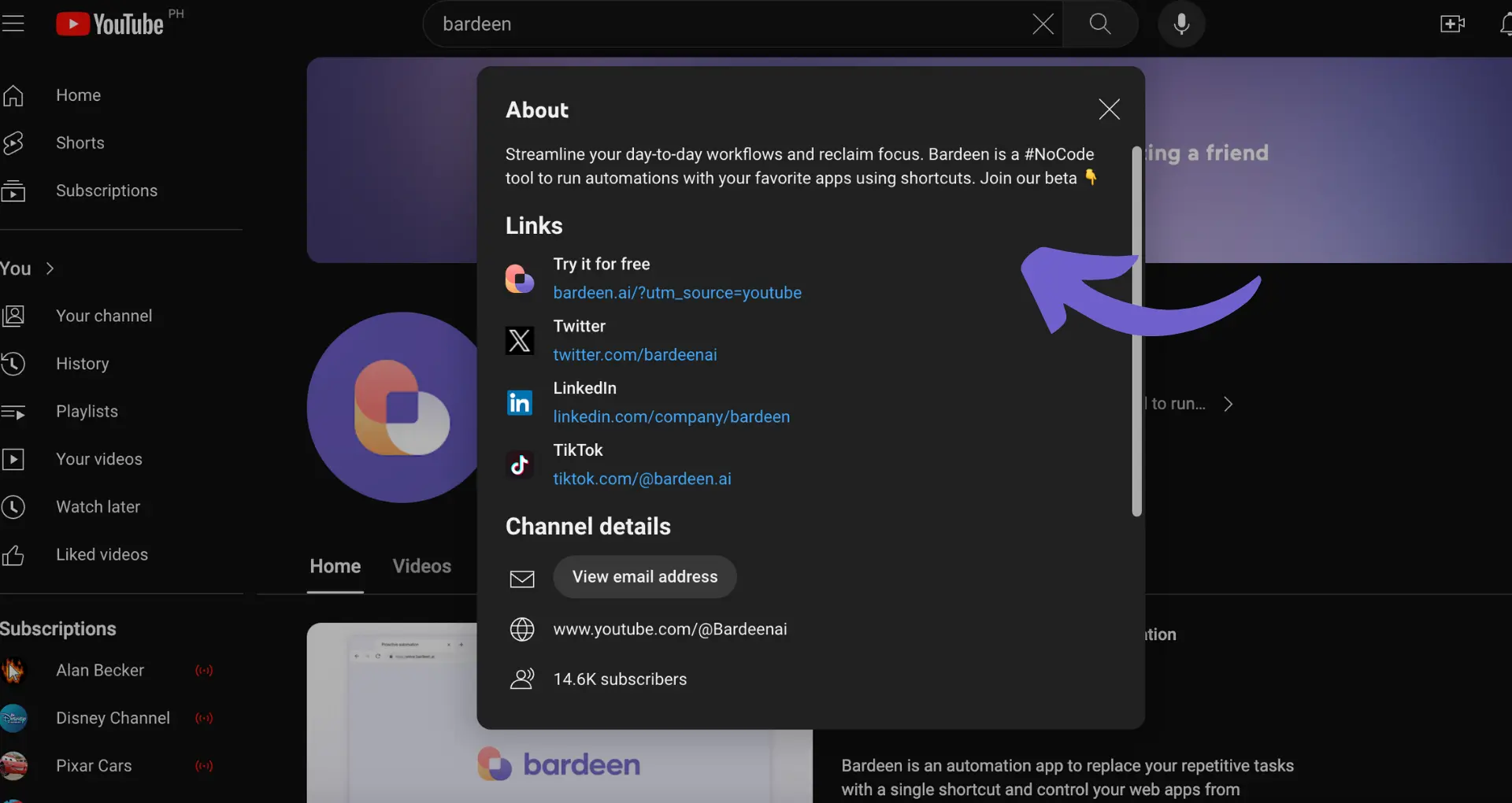Cluttered LinkedIn messages with outdated attachments can be a real headache. Not only do they take up valuable storage space, but they can also compromise your privacy and slow down your LinkedIn experience. In this quick guide, we'll walk you through the simple steps to remove those pesky attachments and keep your inbox organized. Plus, discover a bonus tip for automating the any repetitive process with AI agents like Bardeen. Ready to declutter and secure your LinkedIn messages? Let's dive in!
Why Remove Attachments from LinkedIn Messages?
Removing attachments from your LinkedIn messages can help declutter your inbox, free up storage space, and improve your account's overall performance. Here are some key reasons to delete old or unnecessary attachments:
1. Organize Your LinkedIn Inbox
As you exchange messages with connections on LinkedIn, attachments can quickly pile up and make it difficult to find important conversations. For example, let's say you've been messaging back and forth with a potential client, sharing project proposals and design mockups. After a few weeks, your message thread may be cluttered with outdated attachments that are no longer relevant.
By removing these old attachments, you can streamline your inbox and focus on the most current and important information. This can save you time and hassle when trying to locate specific messages or files.
2. Free Up Storage Space
LinkedIn provides a generous amount of storage space for messages and attachments, but it's not unlimited. Over time, large attachments like high-resolution images, videos, or lengthy documents can eat up your allotted space.
Deleting attachments you no longer need can help free up valuable storage space for new, more important files. This is especially helpful if you frequently use LinkedIn to share and collaborate on projects with clients or colleagues.
3. Protect Your Privacy and Security
In some cases, you may have shared sensitive information or confidential documents with a connection via LinkedIn message. While LinkedIn takes steps to secure your data, it's always a good idea to remove any attachments containing private or proprietary information once they're no longer needed.
For instance, imagine you sent a contract or financial report to a client for review. Once they've acknowledged receipt and the document is no longer needed, it's best to delete the attachment from your LinkedIn messages to reduce the risk of unauthorized access or accidental sharing.
4. Improve LinkedIn's Performance
Large numbers of attachments, particularly those with large file sizes, can sometimes slow down LinkedIn's loading speed and overall performance. By regularly cleaning out your old attachments, you may notice a smoother, faster experience when navigating your inbox and messages.
This performance boost can save you time and frustration, especially if you rely on LinkedIn for important business communication and networking.
Removing unnecessary attachments from your LinkedIn messages is a simple but effective way to keep your inbox organized, protect your privacy, and optimize your LinkedIn experience. Learn more about using tools to connect LinkedIn with other apps for enhanced productivity.
In the next section, we'll walk you through the steps to easily delete attachments using LinkedIn's desktop site.
Deleting Attachments on LinkedIn's Desktop Site
Removing attachments from LinkedIn messages on your desktop is a straightforward process. Follow these simple steps to locate the conversation, access the attachment options, and permanently delete the file.
1. Find the Conversation with the Attachment
Start by logging into your LinkedIn account on your desktop browser. Navigate to your messaging inbox and scroll through your conversations until you find the one containing the attachment you want to remove.
For example, let's say you've been discussing a project proposal with a client and have sent them a draft document. After receiving their feedback, you realize you need to delete the outdated attachment to avoid confusion.
2. Access the Attachment Options Menu
Once you've located the conversation, hover your cursor over the attachment you want to delete. An options menu should appear, giving you access to various actions you can take with the file.
In our project proposal example, hovering over the draft document attachment will reveal the menu, allowing you to proceed with the deletion process.
3. Click "Delete Attachment" and Confirm
From the attachment options menu, click on the "Delete attachment" button. LinkedIn will prompt you to confirm your action, ensuring you intended to remove the file from the conversation. Tools like Bardeen's LinkedIn Data Scraping can help manage and organize your LinkedIn data efficiently.
After clicking "Delete," the attachment will be permanently removed from the message thread. It's important to note that this action cannot be undone, so be sure you truly want to delete the attachment before confirming.
Use scrape LinkedIn tools to automate data management and keep everything organized without manual hassle.
4. Deletion is Permanent and Irreversible
Keep in mind that once you delete an attachment from a LinkedIn message, it cannot be recovered. The file is permanently erased from the conversation and cannot be accessed by you or the other participants.
If you think you may need the attachment again in the future, consider saving a copy of the file to your computer or cloud storage before deleting it from LinkedIn. This way, you can still access the document if needed without cluttering your LinkedIn messages.
Deleting attachments from your LinkedIn messages on desktop is a quick and easy way to keep your conversations organized and clutter-free. Remember to carefully consider which attachments you want to remove, as the deletion process is permanent.
Next, we'll explore how to remove LinkedIn message attachments using the mobile app, ensuring you can keep your inbox tidy on the go.
Removing LinkedIn Message Attachments on Mobile Devices
Deleting attachments from LinkedIn messages on your mobile device is just as easy as on desktop. Whether you're using an iOS or Android device, you can quickly locate the conversation, access the attachment options menu, and remove the file permanently.
1. Open the LinkedIn App and Find the Conversation
Begin by launching the LinkedIn app on your mobile device. Tap on the messaging icon to access your inbox, then scroll through your conversations to find the one containing the attachment you want to delete.
Let's say you've been discussing a job opportunity with a recruiter and have sent them your resume. After updating your resume, you realize you need to remove the outdated version from the conversation to avoid any confusion. You can also scrape LinkedIn profiles to keep your contacts current.
2. Tap and Hold the Attachment for Options
Once you've located the conversation and the specific attachment, tap and hold on the file. This action will bring up a menu with various options, including the ability to delete the attachment.
In our job opportunity example, tapping and holding on the outdated resume will reveal the action menu, allowing you to proceed with the deletion process.
3. Look for "Delete Attachment" or Similar Options
The exact wording of the delete option may vary depending on your device and the version of the LinkedIn app you're using. Look for phrases like "Delete attachment," "Remove," or even a trash can icon.
Regardless of the specific terminology, the goal is to find and select the option that allows you to remove the attachment from the conversation permanently.
4. Deletion is Still Permanent on Mobile
Just like on desktop, deleting an attachment from a LinkedIn message on mobile is a permanent action. Once you confirm the deletion, the file will be erased from the conversation and cannot be recovered.
If you think you may need the attachment again in the future, consider saving a copy of the file to your mobile device or a cloud storage service before removing it from the LinkedIn message.
Removing LinkedIn message attachments on mobile devices is a straightforward process that helps keep your conversations organized and clutter-free. Remember to exercise caution when deleting attachments, as the action is irreversible.
Next up, we'll explore some handy tips for managing your LinkedIn message attachments more effectively, ensuring your inbox stays tidy and efficient.
Tips for Managing LinkedIn Message Attachments
Managing your LinkedIn message attachments is crucial for maintaining an organized and efficient inbox. By regularly reviewing and purging unneeded files, saving important attachments elsewhere, and being selective about accepting new ones, you can keep your conversations clutter-free and running smoothly.
1. Regularly Review and Purge Unneeded Attachments
Make it a habit to periodically go through your LinkedIn messages and delete any attachments you no longer need. This practice will help keep your conversations lean and prevent unnecessary storage space from being consumed.
For example, if you've been discussing a project with a colleague and have exchanged multiple versions of a document, once the final version is agreed upon, you can safely remove the outdated drafts from the conversation.
2. Save Important Attachments Before Deleting
Before removing an attachment from a LinkedIn message, consider whether you may need to access it again in the future. If so, be sure to save a copy of the file to your local device or a cloud storage service.
This way, you can keep your LinkedIn messages tidy without losing access to important documents or media. It's always better to err on the side of caution when it comes to preserving valuable files.
3. Encourage External File Sharing for Large Attachments
If someone sends you a particularly large attachment via LinkedIn message, it's a good idea to suggest using an external file sharing service instead. This approach will help prevent your inbox from becoming bogged down with oversized files.
Services like Google Drive, Dropbox, or OneDrive offer convenient ways to share large files without cluttering up your LinkedIn messages. Plus, these platforms often provide more robust collaboration and version control features.
4. Be Selective About Accepting New Attachments
To minimize the need for future attachment management, be thoughtful about which files you accept in the first place. If someone sends you an unsolicited attachment that doesn't seem relevant or necessary, feel free to politely decline it.
By being selective about the attachments you allow into your LinkedIn messages, you can proactively reduce clutter and keep your conversations focused on what matters most.
Implementing these tips will help you keep your LinkedIn message attachments under control, saving you time and hassle in the long run. Thanks for sticking with us through this guide—we promise it'll be worth it when your inbox is sparkling clean!
Banish clutter in your LinkedIn messages and make sharing files smoother by using Bardeen to generate emails with AI. Streamline communication and save time by automating your outreach and file-sharing tasks effortlessly.
Conclusions
Knowing how to remove LinkedIn message attachments is crucial for keeping your inbox organized and secure. For those seeking to enhance their LinkedIn management, consider using LinkedIn phone number extractor tools to streamline data collection.
This guide covered:
- The importance of removing attachments to declutter, organize, and protect your privacy
- Step-by-step instructions for deleting attachments on LinkedIn's desktop site
- The process of removing LinkedIn message attachments on mobile devices
- Practical tips for managing your LinkedIn message attachments effectively
By mastering the art of deleting attachments in LinkedIn messages, you'll avoid the chaos of a cluttered inbox. Don't let attachment overload hold you back from LinkedIn messaging success!






